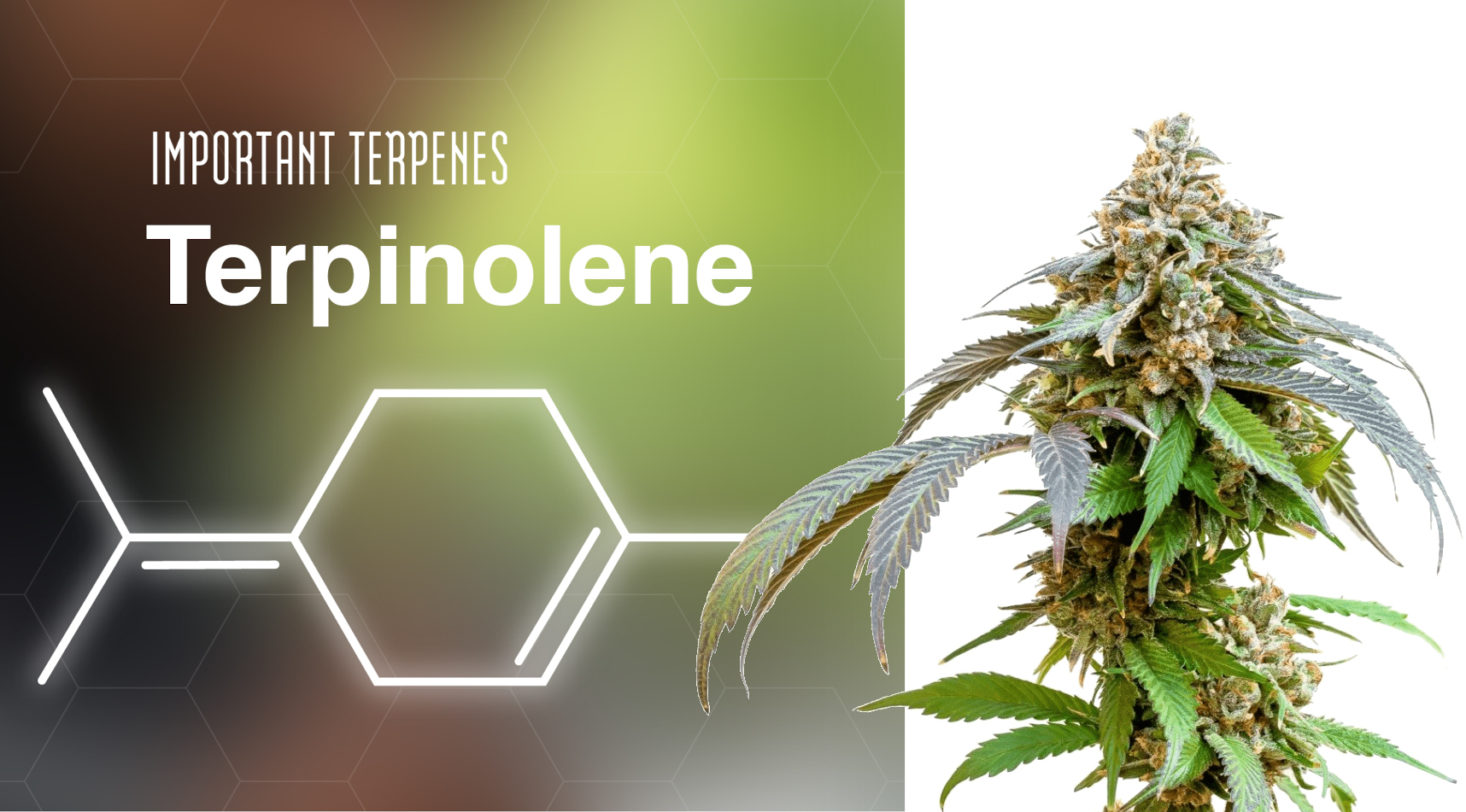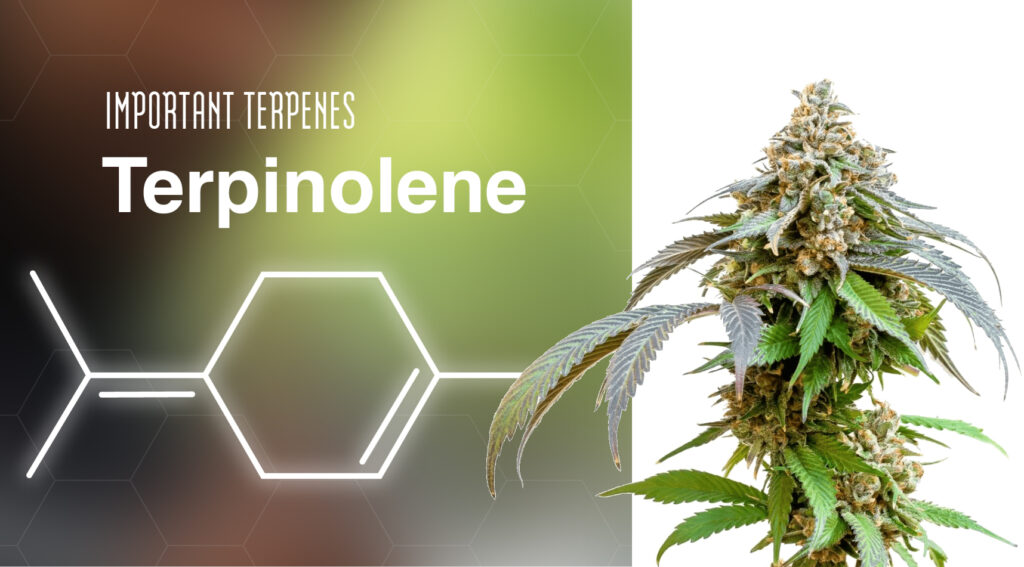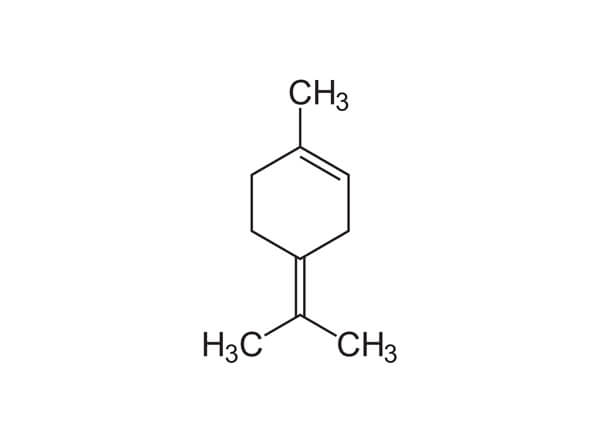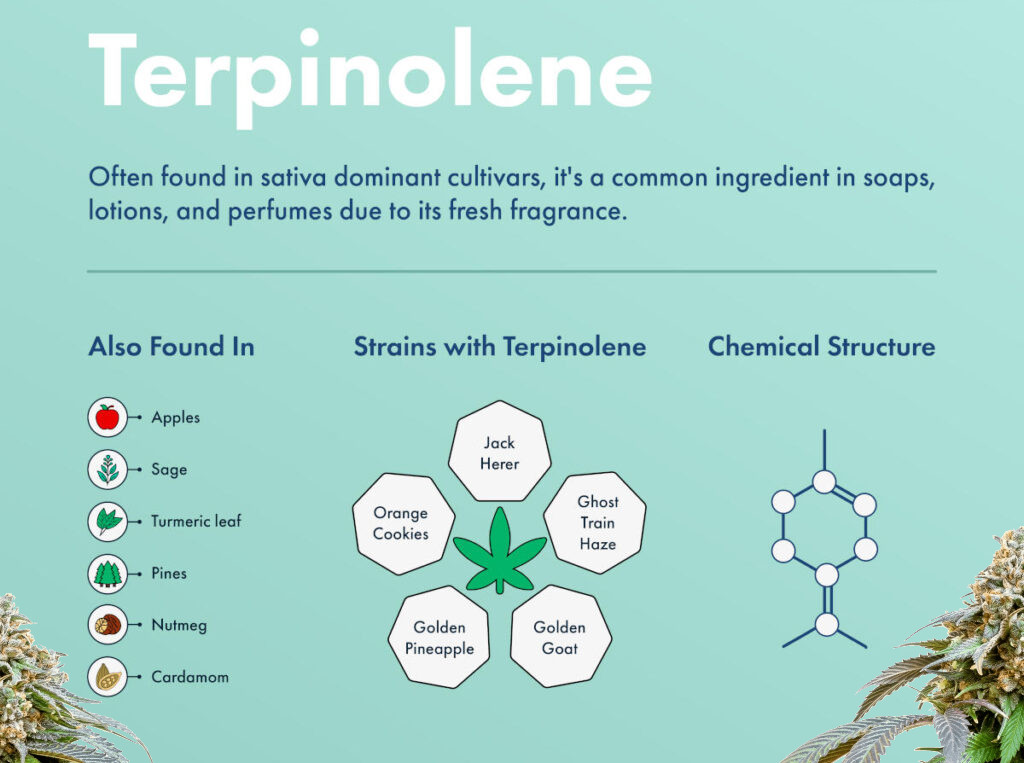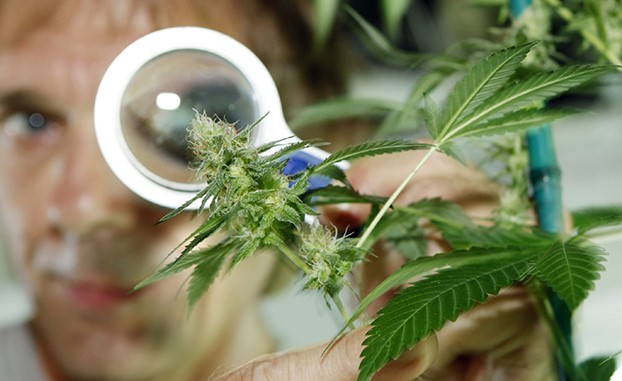Terpinolene, a naturally occurring organic compound, is one of the lesser-known yet incredibly fascinating terpenes found in various plants, particularly in cannabis. This versatile compound doesn’t just contribute to the aroma and flavor profiles of different plants; it also boasts a range of potential health benefits and unique effects on the human body. In this comprehensive article, we delve deep into the world of terpinolene, exploring its origins, chemical composition, and its effects on both the human body and the natural environment. Whether you’re a curious consumer, a health enthusiast, or a botany aficionado, this exploration of Terpinolene’s effects promises to enlighten and inform
Table of Contents:
A. Definition and Natural Occurrence
B. Importance in Aromatherapy and Culinary Industry
A. Presence in Various Cannabis Strains
B. Aroma, Flavor, and Synergies with Other Compounds
III. Health Benefits and Medicinal Uses
A. Antioxidant and Anti-inflammatory Properties
B. Potential in Cancer Prevention and Cardiovascular Health
C. Impact on Sleep and Appetite Regulation
IV. Terpinolene’s Impact on Human Physiology
A. Effects on the Nervous System and Mood
B. Safety and Potential Side Effects
V. Terpinolene’s Environmental Significance
A. Ecological Role and Natural Pesticidal Properties
B. Soil and Plant Health
VI. Terpinolene in Traditional and Modern Medicine
A. Historical Uses and Traditional Medicine Practices
B. Terpinolene-based Products in the Market
VII. Future Research and Developments
A. Ongoing Studies and Emerging Applications
B. Innovations in Terpinolene Extraction
I.Understanding Terpinolene
A. Definition and Natural Occurrence
Terpinolene is a monocyclic terpene, a class of organic compounds widely distributed in the plant kingdom. Chemically, it is classified as a member of the terpene hydrocarbons, a diverse group of compounds known for their aromatic properties and various biological activities. Terpinolene is characterized by its molecular formula C10H16, consisting of ten carbon atoms and sixteen hydrogen atoms.
Natural Occurrence:
This compound is naturally present in numerous plant species, including but not limited to, cannabis, oregano, sage, marjoram, and citrus fruits. Its abundance in these plants contributes to their distinct aroma and flavor profiles. In cannabis, terpinolene is one of the many terpenes found in trichomes, the resin glands of the plant. Interestingly, terpinolene is not specific to cannabis and can be found in various other plants, showcasing its widespread occurrence in nature. Its presence in different botanical sources highlights the terpene’s ecological significance and its role in the natural defense mechanisms of plants against pests and environmental stressors.
B. Importance in Aromatherapy and Culinary Industry:
Terpinolene holds significant importance in both the aromatherapy and culinary realms due to its pleasing aroma and potential therapeutic properties.
1. Aromatherapy:
In aromatherapy, terpinolene is valued for its sweet, floral, herbal, and citrusy aroma. When used in essential oils or diffusers, its scent is believed to have calming and relaxing effects on the mind and body. Aromatherapists often utilize terpinolene-rich oils to promote a sense of tranquility and alleviate stress and anxiety. Its subtle, yet delightful fragrance makes it a popular choice for blending with other essential oils to create balanced and aromatic blends for aromatherapeutic purposes.
2. Culinary Industry:
Terpinolene contributes to the flavors and aromas of various culinary delights. It is commonly found in spices like oregano, marjoram, and cumin, adding a unique depth to the taste profile. Additionally, terpinolene is a key component in the formulation of natural flavorings and fragrances used in the food industry. Its citrusy and floral notes enhance the taste of sauces, baked goods, and beverages. Terpinolene’s ability to add complexity to culinary creations makes it a sought-after ingredient among chefs and food product developers. Its natural origin aligns with the growing consumer preference for natural and organic flavors in the food and beverage industry, further emphasizing its significance in culinary applications.
II. Terpinolene in Cannabis
A. Presence in Various Cannabis Strains
Terpinolene is one of the many terpenes found in cannabis, contributing to the complex aromatic and flavor profiles of different strains. Its presence in cannabis plants varies widely, with some strains exhibiting higher terpinolene content than others. This variation in terpinolene levels gives each cannabis strain its distinct aroma and taste, influencing consumers’ sensory experiences.
Certain sativa-dominant strains are notably high in terpinolene. Sativa strains, known for their energizing and uplifting effects, often contain higher concentrations of this terpene. Terpinolene’s aroma is characterized by its sweet and floral notes, with hints of citrus and herbal undertones. When present in significant amounts, terpinolene can contribute to the strain’s overall aroma, creating a unique olfactory experience for users.
Terpinolene and the Entourage Effect
Apart from its aromatic contribution, terpinolene also plays a role in the entourage effect, a phenomenon where the combined presence of cannabinoids, terpenes, and other compounds enhances the overall therapeutic effects of cannabis. Terpinolene’s interaction with other cannabinoids and terpenes in the plant may influence the strain’s overall physiological effects, making it a relevant factor for both recreational and medicinal cannabis users seeking specific experiences. Understanding the presence of terpinolene in various cannabis strains is crucial for users and cultivators alike, allowing for informed choices based on desired aromas, flavors, and potential effects.
Some strains with higher levels of Terpinolene
- Jack Herer: This popular sativa-dominant strain is often cited as having high terpinolene content. It’s known for its uplifting effects and earthy, pine, and citrus aroma.
- Golden Goat: Golden Goat is a sativa-dominant hybrid with a sweet and spicy aroma. It’s believed to be high in terpinolene and is appreciated for its euphoric and creative effects.
- Ghost Train Haze: Ghost Train Haze is a potent sativa strain with a strong terpinolene presence. It’s recognized for its citrus and floral aroma and its energizing effects.
- Dutch Treat: This indica-dominant hybrid has a sweet, fruity, and earthy flavor profile. It’s reported to be high in terpinolene and is known for its relaxing and euphoric effects.
- Chernobyl: Chernobyl is a sativa-dominant hybrid with a terpinolene-rich profile. It has a citrusy and lime aroma and is appreciated for its mood-enhancing and stress-relieving properties.
- XJ-13: This sativa-dominant hybrid is known for its citrus and pine aroma. It’s believed to have high terpinolene levels and offers a clear-headed, energetic high.
- Romulan: Romulan is an indica strain with a piney and earthy aroma. Some variations of this strain are reported to be high in terpinolene. It’s known for its relaxing and sedative effects.
- Super Lemon Haze: This sativa-dominant hybrid has a zesty, lemony aroma with hints of sweetness. It’s often cited as having high terpinolene levels and is recognized for its uplifting and euphoric effects.
B. Aroma, Flavor, and Synergies with Other Compounds:
1. Aroma:
Terpinolene contributes a distinctive aromatic profile to cannabis strains. Its aroma is characterized by a delightful blend of sweet citrus, floral notes, and herbal undertones. The terpene’s complex bouquet gives rise to a diverse range of scents, from fresh and zesty to subtly woody, making it a key component in creating unique olfactory experiences.
2. Flavor:
When it comes to flavor, terpinolene introduces a palate-pleasing mix of citrusy, herbal, and spicy notes. Strains high in terpinolene often carry a refreshing taste profile, reminiscent of fruits like oranges and lemons, combined with hints of earthiness and mild spice. This combination provides a satisfying and nuanced flavor profile that many enthusiasts find appealing.
3. Synergies with Other Compounds:
Terpinolene’s presence in cannabis doesn’t just contribute to its aroma and flavor; it also interacts synergistically with other compounds, including cannabinoids and terpenes. This synergy is part of what’s known as the entourage effect, where the combined effects of various cannabis compounds create a more profound impact than each individual component on its own.
In the case of terpinolene, its synergistic interactions can modify and enhance the overall effects of a particular strain. For example, when combined with cannabinoids like THC and CBD, terpinolene might influence the strain’s psychoactive and therapeutic effects. Additionally, its interaction with other terpenes can further diversify the sensory experience and potentially contribute to the overall therapeutic benefits, creating a harmonious balance in the strain’s effects.
Understanding these synergies is essential for both recreational users seeking specific experiences and medical users looking for targeted therapeutic effects. Terpinolene’s ability to blend seamlessly with other compounds showcases its significance in shaping the complex and multifaceted nature of cannabis strains, making it a vital component of the cannabis plant’s overall therapeutic and sensory profile.
III. Health Benefits and Medicinal Uses of Terpinolene
A. Antioxidant and Anti-inflammatory Properties:
Terpinolene, beyond its aromatic charm, holds immense promise in the realm of health and wellness due to its potent antioxidant and anti-inflammatory properties.
1. Antioxidant Properties:
Terpinolene acts as a robust antioxidant, helping the body combat oxidative stress. Oxidative stress occurs when there is an imbalance between free radicals (unstable molecules) and antioxidants in the body. This imbalance can lead to cell damage and is linked to various chronic diseases and aging. Terpinolene’s antioxidant prowess lies in its ability to neutralize free radicals, protecting cells from damage. By scavenging these harmful molecules, terpinolene aids in reducing the risk of chronic conditions, supporting overall cellular health, and promoting longevity.
2. Anti-inflammatory Effects:
Inflammation is a natural immune response, but chronic inflammation can lead to several health issues, including cardiovascular diseases, diabetes, and autoimmune disorders. Terpinolene exhibits anti-inflammatory properties by inhibiting the production of inflammatory molecules in the body. By modulating the inflammatory response, terpinolene can help alleviate symptoms associated with inflammatory conditions. These anti-inflammatory effects not only contribute to overall well-being but also make terpinolene a potential candidate for the development of anti-inflammatory medications.
Understanding and harnessing terpinolene’s antioxidant and anti-inflammatory properties have far-reaching implications in the fields of preventive medicine and therapeutic interventions. As research in this area continues to unfold, terpinolene may pave the way for novel treatments and holistic approaches to managing various health conditions, enhancing the quality of life for individuals seeking natural and effective remedies.
B. Potential in Cancer Prevention and Cardiovascular Health:
Terpinolene, an intriguing terpene with multifaceted properties, has shown promise in the realms of cancer prevention and cardiovascular health, making it a subject of growing interest in scientific research.
1. Cancer Prevention:
Studies have indicated that terpinolene possesses certain anti-cancer properties. It acts as a natural compound that may help inhibit the growth of cancer cells. Research suggests that terpinolene has cytotoxic effects on various cancer cell lines, making it a potential candidate for cancer prevention and treatment. By disrupting the growth and proliferation of cancer cells, terpinolene shows promise in being part of the arsenal against certain types of cancers. However, it’s crucial to note that while these preliminary findings are promising, further research is needed to fully understand terpinolene’s mechanisms and its potential applications in cancer prevention and therapy.
2. Cardiovascular Health:
Terpinolene’s antioxidant and anti-inflammatory properties are particularly relevant in the context of cardiovascular health. Oxidative stress and inflammation play significant roles in the development of cardiovascular diseases, including heart attacks and strokes. By neutralizing free radicals and reducing inflammation, terpinolene may contribute to maintaining healthy cardiovascular function. Additionally, terpinolene’s potential to modulate cholesterol levels and support blood circulation further underscores its relevance in promoting heart health. While research is ongoing, these properties suggest that terpinolene could be part of a holistic approach to cardiovascular disease prevention, potentially reducing the risk factors associated with heart-related conditions.
The exploration of terpinolene’s role in cancer prevention and cardiovascular health signifies a step forward in understanding the terpene’s therapeutic potential. As research advances, terpinolene may emerge as a valuable natural compound, offering new avenues for preventive healthcare strategies and innovative approaches to managing complex health conditions.
C. Impact on Sleep and Appetite Regulation:
Terpinolene, the versatile terpene found in various plant species, including cannabis, has demonstrated intriguing effects on sleep patterns and appetite regulation, making it a subject of interest in the fields of sleep medicine and nutrition.
1. Sleep Regulation:
Terpinolene’s interaction with the central nervous system suggests potential implications for sleep regulation. Some cannabis strains high in terpinolene content are reported to have relaxing and sedative effects. While individual responses can vary, terpinolene’s calming properties may help individuals struggling with sleep disorders, such as insomnia. By promoting relaxation and easing anxiety, terpinolene-rich strains might offer a natural alternative for those seeking better sleep quality. However, it’s important to note that research in this area is still evolving, and individual responses to terpinolene can differ significantly.
2. Appetite Modulation:
Terpinolene’s effects on appetite regulation are a subject of interest, especially considering its presence in cannabis strains that are associated with increased appetite, often referred to as “the munchies.” While the exact mechanisms are not fully understood, terpinolene, in combination with other cannabinoids and terpenes, might influence appetite. For individuals dealing with appetite-related challenges, such as lack of appetite due to medical conditions or treatments, terpinolene-rich strains might provide relief. However, it’s essential to approach such applications cautiously and under professional guidance to ensure safe and effective usage.
Understanding terpinolene’s impact on sleep and appetite regulation sheds light on its potential therapeutic applications. As research progresses, the terpene’s precise mechanisms and its role in promoting healthy sleep patterns and balanced appetite may offer new avenues for natural remedies in the fields of sleep disorders and nutrition.
IV. Terpinolene and its Impact on Human Physiology
A. Effects on the Nervous System and Mood
Terpinolene, a terpene abundant in various plant species, including cannabis, exerts distinct effects on the human nervous system and mood, offering a nuanced understanding of its potential physiological impact.
1. Nervous System Modulation:
Terpinolene interacts with neurotransmitter receptors in the brain, potentially influencing the central nervous system. While the exact mechanisms are still under exploration, terpinolene-rich cannabis strains are believed to have unique effects on neural pathways. Some individuals report feelings of relaxation and mental clarity when consuming terpinolene-rich strains, suggesting a calming influence on the nervous system. This calming effect may be particularly beneficial for individuals dealing with stress, anxiety, or restlessness. However, it is essential to recognize that individual responses to terpinolene can vary widely, and further research is necessary to establish specific neurological pathways and their modulation by this terpene.
2. Mood Enhancement and Stress Relief:
Terpinolene’s aromatic profile, characterized by its sweet, floral, and citrusy notes, is often associated with mood enhancement. Inhalation of terpinolene vapor or exposure to its aroma in aromatherapy practices can evoke feelings of relaxation and may help alleviate stress and anxiety. While terpinolene’s impact on mood is thought to be linked to its interaction with certain receptors in the brain, more research is needed to delineate the precise mechanisms responsible for its mood-enhancing properties.
The exploration of terpinolene’s effects on the nervous system and mood provides valuable insights into its potential applications in managing stress-related disorders and promoting mental well-being. As scientific understanding deepens, terpinolene may emerge as a valuable natural compound for individuals seeking holistic approaches to support mental health and enhance overall mood and relaxation.
B. Safety and Potential Side Effects:
While terpinolene offers a range of potential benefits, it’s crucial to consider its safety profile and potential side effects when exploring its applications.
1. Safety Considerations:
Terpinolene is generally regarded as safe when consumed in moderate amounts, either through dietary sources or in products containing this terpene. However, as with any natural compound, individual responses can vary. It’s important to note that the safety of terpinolene in concentrations significantly higher than those found in natural sources, especially when isolated or in concentrated forms, has not been extensively studied. Therefore, caution is advised when using products specifically formulated with terpinolene, especially in high doses.
2. Potential Side Effects:
While terpinolene is generally well-tolerated, some individuals might experience mild side effects. These can include dizziness, headache, or mild allergic reactions. Additionally, as with other cannabis-related products, terpinolene-rich strains might cause dry mouth and red eyes, common side effects associated with marijuana use. Furthermore, individuals prone to cannabis-induced anxiety might experience heightened symptoms with terpinolene-rich strains, although individual responses can vary widely.
Moreover, individuals with specific medical conditions, such as respiratory issues or allergies, should exercise caution when inhaling terpinolene vapor, especially in concentrated forms. Pregnant or nursing individuals, as well as those with a history of heart conditions or psychiatric disorders, should consult healthcare professionals before using terpinolene-containing products.
In summary, while terpinolene is generally considered safe when consumed in natural, moderate amounts, individuals should be mindful of their own tolerance levels and potential sensitivities. When considering the use of terpinolene-rich products, consulting healthcare providers, especially for individuals with pre-existing medical conditions or sensitivities, is advised to ensure safe and responsible usage.
V. Terpinolene and its Environmental Significance
A. Ecological Role and Natural Pesticidal Properties:
Terpinolene, a terpene widely distributed in the plant kingdom, plays a crucial ecological role and exhibits natural pesticidal properties, contributing to the balance and well-being of natural ecosystems.
1. Ecological Role:
In nature, terpinolene serves as a defense mechanism for plants, helping them deter herbivores and repel pests. Plants containing terpinolene have evolved to produce this terpene as a natural defense against insects, fungi, and bacteria. By acting as a natural repellent, terpinolene assists plants in safeguarding their foliage, fruits, and seeds, promoting their survival and reproduction. Additionally, the terpene’s aromatic nature often attracts beneficial insects and predators, creating a harmonious ecological balance in the plant’s immediate environment.
2. Natural Pesticidal Properties:
Terpinolene’s pesticidal properties have been harnessed for centuries in agriculture and horticulture. Due to its toxicity to certain insects and pests, terpinolene is utilized in natural and organic pest control methods. When extracted and formulated properly, terpinolene-based insecticides and repellents can be used to protect crops without harming the environment, beneficial insects, or non-target organisms. This natural approach to pest management reduces the reliance on synthetic chemical pesticides, promoting sustainable agriculture and contributing to the preservation of biodiversity.
Furthermore, terpinolene’s presence in soil can influence the surrounding microorganisms, enhancing the soil’s health and fertility. It can deter harmful soil-borne pathogens, promoting a thriving ecosystem beneath the surface. This interplay between terpinolene-producing plants and the environment showcases the terpene’s vital role in maintaining the delicate balance of natural habitats.
Understanding terpinolene’s ecological significance highlights its importance beyond its aromatic and therapeutic properties. As an essential component of plant defense mechanisms and natural pest control, terpinolene contributes significantly to the health of ecosystems and underscores the intricate relationship between plants and the environment.
B. Soil and Plant Health:
Terpinolene, a naturally occurring terpene found in various plant species, plays a significant role in maintaining soil and plant health, fostering a symbiotic relationship between plants and their surrounding environment.
1. Soil Health:
Terpinolene’s presence in the soil contributes to its overall health and fertility. This terpene exhibits natural antibacterial and antifungal properties, acting as a defense mechanism against harmful soil-borne pathogens. By inhibiting the growth of these microorganisms, terpinolene supports a balanced soil ecosystem. In turn, this promotes the growth of beneficial soil microbes, essential for nutrient cycling and the breakdown of organic matter. The terpene’s influence helps create a healthy soil structure, ensuring that plants have access to essential nutrients and minerals necessary for their growth and development.
2. Plant Health:
For plants, terpinolene functions as a natural shield against pests and pathogens. When absorbed by plant roots, terpinolene can act as a deterrent to soil-dwelling insects and nematodes, protecting plant roots from damage. Additionally, when terpinolene is released into the surrounding soil, it can discourage the growth of harmful fungi and bacteria, reducing the risk of plant diseases. This natural defense mechanism contributes to the overall vitality of plants, enhancing their ability to thrive in their respective ecosystems.
Moreover, terpinolene’s role in plant health extends to its potential influence on the plant’s resilience to environmental stressors, such as drought and extreme temperatures. Research suggests that terpinolene, along with other terpenes, might play a part in a plant’s adaptation to environmental challenges, bolstering their ability to withstand adverse conditions.
In conclusion, terpinolene’s impact on soil and plant health underscores its ecological importance. By promoting a balanced soil ecosystem and providing natural defenses against pests and diseases, terpinolene contributes to the sustainability of plant life and ecosystems, highlighting the terpene’s integral role in the natural world.
VI. Terpinolene in Traditional and Modern Medicine
A. Historical Uses and Traditional Medicine Practices:
Terpinolene, a terpene found in various plants, has a rich history of traditional uses in folk medicine practices around the world, spanning cultures and centuries.
1. Traditional Uses:
In traditional medicine, terpinolene-rich plants have been used for their medicinal properties for generations. Ancient civilizations, including those in Egypt, Greece, and China, utilized plants containing terpinolene for their aromatic and therapeutic benefits. Terpinolene was often employed to treat respiratory ailments due to its expectorant properties. Additionally, its calming aroma made it a popular choice in aromatherapy practices, where it was used to alleviate stress, anxiety, and promote relaxation.
2. Traditional Healing Cultures:
Indigenous cultures in various parts of the world incorporated terpinolene-containing plants into their healing practices. These plants were often used in remedies for digestive issues, skin conditions, and as natural insect repellents. Terpinolene’s natural antifungal and antibacterial properties made it valuable in treating wounds and infections. Moreover, terpinolene was sometimes used to create aromatic oils and balms for massage and therapeutic rituals, enhancing the overall well-being of individuals.
3. Modern Applications:
In modern times, terpinolene continues to find applications in the field of complementary and alternative medicine. Its potential antioxidant, anti-inflammatory, and antimicrobial properties have sparked interest among researchers and healthcare practitioners. While further scientific research is needed to validate many of these claims, terpinolene is being explored for its potential role in formulations for skincare products, aromatherapy blends, and natural remedies. It is also being investigated for its possible contribution to cancer research, although this area of study is still in its early stages.
Understanding terpinolene’s historical significance in traditional medicine provides valuable insights into its diverse applications and potential therapeutic benefits. As research progresses, the terpene’s rich legacy in traditional healing practices may pave the way for innovative approaches in modern medicine, offering natural solutions for various health and well-being needs.
B. Terpinolene-based Products in the Market:
The versatile terpene, terpinolene, has found its way into a wide array of products in the modern market, showcasing its adaptability and potential in various industries.
1. Aromatherapy and Essential Oils:
Terpinolene is a common component in aromatherapy products and essential oils. Its pleasant aroma, often described as floral and citrusy, is incorporated into essential oil blends used for relaxation, stress relief, and mood enhancement. Terpinolene’s calming properties make it a popular choice for diffusers, massage oils, and scented candles, creating soothing environments in homes and wellness centers.
2. Skincare and Personal Care Products:
Due to its natural antimicrobial and antioxidant properties, terpinolene is utilized in skincare formulations. It can be found in creams, lotions, and serums, offering potential benefits for the skin. Terpinolene’s presence in these products is often aimed at promoting skin health, reducing inflammation, and providing a refreshing scent in various cosmetic items.
3. Cannabis-based Products:
Terpinolene is a significant component in cannabis strains, contributing to their aroma and potential effects. In regions where cannabis is legal, terpinolene-rich strains are utilized for various products, including edibles, oils, and topicals. These products aim to harness terpinolene’s potential synergistic effects with other cannabinoids for both recreational and medicinal purposes. Its presence in cannabis-based formulations highlights its role in the growing cannabis industry.
4. Natural Cleaning and Pest Control Products:
Terpinolene’s natural pesticidal properties make it valuable in eco-friendly cleaning and pest control products. It is incorporated into natural insect repellents and environmentally safe cleaning solutions, providing an alternative to chemical-based products. Terpinolene’s effectiveness against pests and its non-toxic nature contribute to its popularity in these applications.
5. Nutraceuticals and Dietary Supplements:
In the realm of dietary supplements, terpinolene is explored for its potential health benefits. It can be found in nutraceuticals, capsules, and herbal supplements, where it is marketed for its antioxidant and anti-inflammatory properties. These products cater to individuals seeking natural and holistic approaches to wellness.
Terpinolene’s diverse applications in the market showcase its adaptability and potential in various industries. As research on this terpene continues, its presence in products across different sectors highlights its significance in the ever-expanding landscape of natural and holistic solutions for consumers.
VII. Future Research and Developments
A. Ongoing Studies and Emerging Applications:
The future of terpinolene research holds exciting prospects, with ongoing studies and emerging applications poised to unlock the terpene’s full potential in various fields.
1. Ongoing Scientific Studies:
Researchers are actively investigating terpinolene’s biological activities, aiming to unravel its precise mechanisms of action. Ongoing studies are focused on understanding how terpinolene interacts with specific receptors in the human body, shedding light on its potential therapeutic applications. Continued research in areas such as neuroscience, immunology, and oncology is expected to provide valuable insights into terpinolene’s effects on the nervous system, immune response, and cancer cells, paving the way for targeted treatments and therapies.
2. Emerging Applications in Medicine:
The pharmaceutical industry is exploring terpinolene’s potential in drug development. As scientists gain a deeper understanding of its properties, terpinolene could become a key ingredient in innovative medications. Its antioxidant, anti-inflammatory, and antimicrobial properties make it a candidate for formulations aimed at treating a variety of ailments, from chronic inflammatory conditions to infectious diseases. Additionally, ongoing research might reveal terpinolene’s role in addressing neurodegenerative disorders, offering hope for patients and healthcare providers alike.
3. Agricultural and Environmental Innovations:
In agriculture, terpinolene’s natural pesticidal properties are being harnessed for eco-friendly pest management strategies. Research is focused on developing terpinolene-based biopesticides that can effectively control agricultural pests while minimizing environmental impact. Furthermore, terpinolene’s influence on soil health and plant growth is being studied to enhance sustainable agricultural practices, promoting healthier crops and reducing the need for synthetic chemicals.
4. Advanced Extraction Techniques:
In the manufacturing sector, advancements in extraction techniques are being explored to efficiently extract terpinolene from plant sources. Novel methods, such as supercritical fluid extraction and molecular distillation, aim to optimize terpinolene extraction processes, ensuring higher purity and yield. These innovations have implications for industries ranging from aromatherapy to pharmaceuticals, ensuring the availability of high-quality terpinolene for various applications.
The future of terpinolene research holds promise for innovative therapies, sustainable agriculture, and environmentally friendly solutions. Ongoing studies and emerging applications are poised to transform our understanding of this versatile terpene, opening doors to a wide array of possibilities for the benefit of human health, agriculture, and the environment.
B. Innovations in Terpinolene Extraction:
The future of terpinolene extraction holds immense promise with continuous innovations in technology and methodologies. Researchers and industry experts are actively exploring advanced techniques to extract terpinolene efficiently and sustainably from various plant sources, ushering in a new era of high-quality terpinolene production.
1. Supercritical Fluid Extraction (SFE):
Supercritical fluid extraction, utilizing substances in a supercritical state as solvents, presents a greener and more efficient method for terpinolene extraction. CO2, often used in this process, allows for precise control over temperature and pressure, ensuring selective extraction of terpinolene while minimizing the degradation of delicate compounds. SFE not only yields higher purity terpinolene but also eliminates the need for harmful chemical solvents, making it an environmentally friendly option.
2. Molecular Distillation:
Molecular distillation, a technique based on differences in molecular weights and boiling points, enables the separation of terpinolene from plant extracts with exceptional precision. This method operates under vacuum conditions, reducing the extraction temperature and preserving the terpene’s integrity. Molecular distillation is particularly effective for extracting terpinolene from sensitive botanicals, ensuring a high-quality and potent terpene extract.
3. Microwave-Assisted Extraction (MAE):
Microwave-assisted extraction employs microwave energy to enhance the extraction process. By selectively heating the plant material and solvent mixture, MAE accelerates the extraction of terpinolene. This method significantly reduces extraction times, making it more energy-efficient and environmentally friendly. Additionally, MAE often results in higher yields and improved terpinolene purity compared to traditional extraction methods.
4. Enzyme-Assisted Extraction (EAE):
Enzyme-assisted extraction involves the use of enzymes to break down cell walls and enhance the release of terpinolene from plant matrices. This environmentally sustainable method reduces the need for high temperatures and harsh solvents, preserving the terpene’s delicate aromatic profile. EAE not only improves extraction efficiency but also ensures a more natural and unaltered terpinolene extract.
5. Nanotechnology Applications:
Nanotechnology offers innovative solutions for terpinolene extraction and encapsulation. Nanoparticles and nanoemulsions can encapsulate terpinolene, enhancing its stability, bioavailability, and shelf life. These nanoformulations are valuable in the development of terpinolene-based pharmaceuticals, nutraceuticals, and cosmetics, ensuring precise dosing and controlled release for optimal therapeutic effects.
These advancements in terpinolene extraction techniques not only contribute to the production of high-quality terpene extracts but also promote sustainability, efficiency, and versatility in its applications. As these innovations continue to evolve, terpinolene’s potential in various industries is poised to expand, leading to a new era of terpene-based products and therapies.
VIII. Conclusion
Terpinolene, a multifaceted terpene with its sweet, citrusy aroma, encapsulates a world of possibilities in both traditional practices and modern applications. This comprehensive exploration has revealed its nuanced influence on human physiology, its historical significance, and its wide-ranging implications for consumers and industries.
Terpinolene’s versatility offers consumers a rich array of choices. Whether selecting cannabis strains, exploring aromatherapy products, or considering natural remedies, understanding terpinolene’s impact is pivotal. Its potential to enhance skincare, promote sustainable agriculture, and influence pharmaceutical innovations creates a dynamic market landscape.
The Future Landscape of Terpinolene Research and Utilization:
Looking ahead, terpinolene stands on the cusp of groundbreaking advancements. Ongoing studies delve into its interactions within the human body, paving the way for targeted therapies. Innovations in extraction techniques, such as supercritical fluid extraction and nanotechnology applications, are reshaping its utilization across diverse sectors. This evolution promises a future where terpinolene’s benefits are harnessed for human well-being, environmental sustainability, and innovative solutions across myriad fields.
In essence, terpinolene represents a convergence of ancient wisdom and contemporary innovation. Its journey from historical herbal remedies to cutting-edge scientific research exemplifies the terpene’s enduring significance. As the terpinolene story continues to unfold, it offers a glimpse into a future where its aromatic allure and multifaceted properties are at the forefront of transformative discoveries and consumer experiences.

